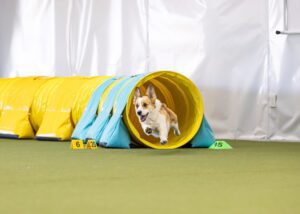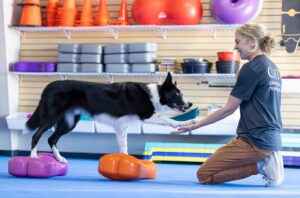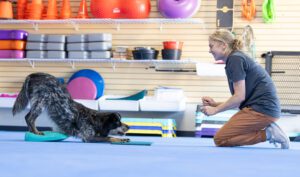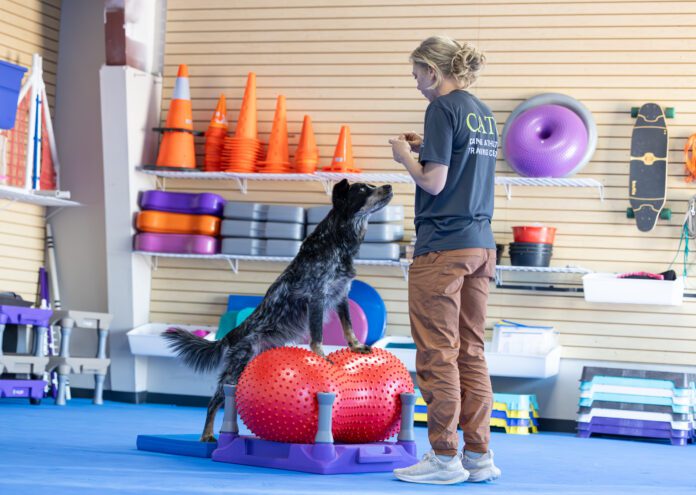Keeping your dog well-exercised has a variety of benefits. Not only will you keep them at a healthy weight and their muscles limber, you can also use exercise as a way to bond with your dog and provide them with mental enrichment.
Before you begin an exercise routine with your dog, there’s a lot to know. We chatted with canine physical therapist Dr. Courtney Wheeler, PT, CCRT, from Walking Paws Rehab in Boulder, Colorado, and canine conditioning coach, Kirsten Belinsky, CPDT-KA, CSCC, from Canine Athletics Training Center in Longmont, Colorado about all things dog exercise.
What Kind of Exercise is Recommended for Dogs?

There are tons of exercise options for pups. Daily walks, running with your dog or engaging in canine sports like agility, flyball, or dock diving are all ways to get your dog active.
Canine conditioning, or strength and fitness training for your dog, is another highly recommended way to exercise your furry friend. Belinsky says that canine conditioning is a great way to prevent injury, build muscle and stability, and work your pup’s brain.
“We ask dogs to activate different muscle groups by putting their paws on different kinds of equipment (both stable and unstable), isolating various body parts, and asking for specific, controlled movements,” she says.
Canine conditioning is a fantastic activity for most dogs. It’s ideal as a cross-training activity for canine athletes who compete in agility, flyball, competitive obedience, and other sports. It’s also helpful for older dogs who need help keeping muscle tone and flexibility and is a great way to build confidence.
“Canine conditioning is elective, and dogs gain confidence by learning new behaviors and getting on new equipment,” says Belinsky.
How Much Should Dogs Exercise?

Before you start canine conditioning or any other dog exercise, Belinsky says that you should make sure your dog is in good physical health.
“They should be cleared for activity by your vet, especially if they have previous injuries,” she says. “You should also take your dog’s current physical fitness level into account when starting — if they don’t get a lot of exercise, don’t start with a lot of conditioning right off the bat.”
If you need help determining how much exercise your dog should be getting, Wheeler recommends taking your pup’s breed, age, and health status into account and gives the following recommendations:
Breed/Drive:
- Consider what your dog was bred to do. Some breeds, like Border Collies, Viszlas, and Huskies, were bred for endurance running and working. These breeds should often be exercised for one to two hours per day through a “combination of walks, off-leash running, or structured play.” Wheeler says that brachycephalic breeds like Pugs or Bulldogs typically require “shorter, gentler activity due to breathing and heat intolerance, such as shorter bursts of play, [and] short, leashed walks during cooler periods of the day.”
Age:
- Puppies: Wheeler recommends short, frequent play sessions and controlled walks with young pups. “Avoid overexertion or repetitive high-impact activities while growth plates are open,” she says. Your dog’s breed and size will impact when their growth plates are fused—typically 18-24 months for large breeds, 6-12 months for small breeds, and 12-14 months for medium breeds.
- Adults: Wheeler says that as a rule of thumb, most healthy adult dogs should get between 30 to 60 minutes per day of moderate to vigorous activity daily.
- Seniors: Just because you have an old dog, doesn’t mean they don’t need exercise. In order to “maintain mobility, circulation, and mental well-being,” Wheeler recommends short, frequent activity sessions for older dogs. “I generally advise people that if your dog looks the same coming back from a walk as when they left the house for his/her walk indicates the perfect distance. It is also important to note how your senior dog is able to transition after their activity—are they slow to rise or stiffer after getting up from a nap following a long walk?”
Health & Conformation:
- “Dogs with orthopedic conditions (like hip dysplasia, arthritis, CCL tears, elbow dysplasia, luxating patellas, etc.) need controlled, low-impact activity,” Wheeler says. “Low-impact exercises include: leash walking, gentle incline work, swimming, or underwater treadmill sessions.”
How Do You Know if You’re Not Exercising Your Dog Enough?
Wheeler says that there are a number of physical signs that can indicate if you’re not exercising your dog enough, weight being one of them.
“If a dog is gaining excess weight or losing muscle mass, it can be a sign they aren’t moving enough, or may be exercised incorrectly,” she says. “On the other hand, dogs that look fit but tire very quickly or recover slowly may not be getting the right kind of exercise.”
Wheeler also recommends that pet parents watch out for joint stiffness, weakness, and decreased endurance/stamina as signs that your dog may not be exercising enough on a regular basis.
From a behavioral perspective, dogs who engage in undesirable behaviors like pacing, whining, or being destructive may need more physical and mental outlets for their energy.
Can Dogs Over-Exercise?
Dogs can easily over-exercise. High drive dogs are known to play until they drop, and Wheeler says that over-exercising can also happen when a dog’s activity level “increases too quickly or is not appropriate for their age, breed, or conformation.”
To prevent overexercising, Wheeler encourages pet parents to learn and keep an eye out for the following red flags:
- Limping or stiffness after activity
- Excessive panting or trouble cooling down during the activity
- Fatigue or reluctance to move the day following the activity
- Desire to spend much of the day lying down instead of engaging in normal activity and interests
- Worn nails or paw pads
- Behavior changes like irritability with their owner and other dogs
What To Consider Before Starting a Dog Exercise Plan
Ensure you take your dog’s age, weight, breed, drive, and health status into account before starting an exercise program, and check with your vet about appropriate outlets for your dog.
Wheeler also notes that it’s important to “adjust the plan based on how the dog is moving during and after activity, rather than how they are acting.”
She mentions that all dogs have different tolerance levels for activity, and that while some dogs will avoid activity if they’re uncomfortable, others will push through discomfort during activities they enjoy.
How To Create an Exercise Routine for Your Dog (and Prevent Injuries)

Start Slow
When creating an exercise routine for your dog, Wheeler says that starting gradually is one of the best ways to ease your dog into activity while preventing injuries. “I like my patients to increase duration before increasing intensity over time,” she says. “For example, increase time hiking with gradual/rolling terrain, before adding or progressing elevation gain.”
Match Exercise to Your Dog’s Conformation
Wheeler also recommends matching exercise options to your dog’s anatomy/conformation. “Some dogs may appear lazy or disinterested in activity when in reality, pain or physical limitations are holding them back,” she says. “A physical therapist or vet can help assess this and guide a safer, more effective routine.”
Mix It Up
Cross-training and variety help prevent injuries and over-exercise and will keep your dog engaged and excited about exercising. “Build each one of these into your dog’s routine: strength work, balance work, flexibility, and bodywork/massage,” says Wheeler.
Mixing up the length and intensity of your dog’s walks and avoiding repetitive motions like daily fetch, agility, flyball, disk, and hiking will help “avoid undue strain on joints and soft tissue,” says Wheeler.
Warm Up Properly
Don’t skip the canine conditioning warm ups. Just like humans, dogs benefit greatly from warming up their muscles before engaging in rigorous activity. Walking for a few minutes and practicing some basic exercises and stretches can help.
Belinsky recommends pet parents teach their dogs a “paws up” command. “By asking your dog to put their front paws on a variety of objects, you are asking them to load weight into their rear end and work those rear end muscles,” she says. “You can change the objects you are using to make it harder—maybe the object is a bit taller, or unstable (such as a yoga ball that you hold onto).”
Teaching your dog to do down-dog stretches on cue, do figure 8s around your legs, or side stepping are other good warm-up options.
Consult a Rehab or Canine Conditioning Specialist
If you’re unsure what activities, durations, or warm-ups are good for your dog, look to a local vet rehab clinic or for a canine conditioning program near you or online. Rehab and canine conditioning professionals can assess your dog and set you up for success when developing a dog exercise program.






